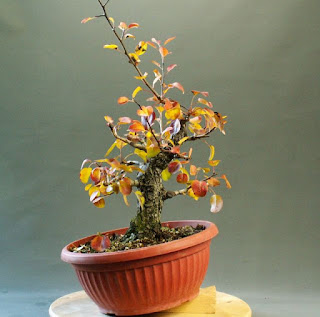Pears are one of the best trees for bonsai in temperate zones. And for me the P. pyraster ( European wild pear ) is really on the top. Cracked bark, tiny fruit and small leaves with spectacular colours in the autumn. That really makes them hard to match. Yes, Prunus mahaleb or blackthorns are great. Aged bark, blossoms, tiny fruits - in all these characteristics they are similar. But when it comes to the autumn color festivity - no match for pears. Unfortunately, there are not many of them on the benches or even shows. Is it because of the fear of the pear rust (Gymnosporangium sabinae ) killing pampered junipers? Difficulty to find /collect one?
The rust might be a problem for sure. But I do not agree with the basic recommendation you may find - if you grow junipers do not grow pears ( and vice versa ). OK, it may sound good, but what about trees grown by your neigbours? The spores may spread hundred of meters from their place of origin by wind or insects. No chance to deal with that. Systemic fungicide and regular removal of affected leaves on pears and twigs on junis is a way I follow. So far no problem with my junipers.
This is one of my wild pear grown in the form typical much more for the common pear than for the wild one.
Height: 42 cm from the rim. W/H ratio below 1:6 ( Not far from 1:5 in fact but it will come...)
The nebari is still forming after the airlayer. But at least there is something that looks like a flare...
Just a few marks of the wire on the branches and new buds to fill the top...
Autumn colors
Just starting...
Another wild pear in full swing of colour festival...










0 Comments